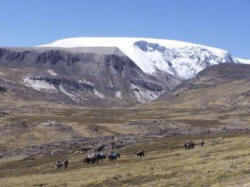|
 Peruvian
ice cap harbors evidence of conquistadors' avarice Peruvian
ice cap harbors evidence of conquistadors' avarice
 Send a link to a friend
Send a link to a friend
[February 11, 2015]
By Will Dunham
WASHINGTON (Reuters) - After vanquishing
the Inca Empire with superior weapons and a touch of treachery, the
Spanish conquistadors sought to satisfy their lust for riches by forcing
multitudes of native people to toil in silver mines in dire conditions
that claimed many lives.
|
|
 Scientists on Monday described evidence of this bitter chapter of
South American history preserved deep in an ice cap in the Peruvian
Andes in the form of residue from the relentless clouds of metallic
dust spewed from the mines starting in the 16th century. Scientists on Monday described evidence of this bitter chapter of
South American history preserved deep in an ice cap in the Peruvian
Andes in the form of residue from the relentless clouds of metallic
dust spewed from the mines starting in the 16th century.
The mountaintop mines of Potosí in Bolivia were the world's richest
silver source.
While the Incas had long extracted silver, a new processing method
introduced by the Spanish in 1572 greatly increased production even
as it belched lead dust and other pollutants into the atmosphere.
The pollution blew over the entire region, including the Quelccaya
Ice Cap some 500 miles (800 km) northwest in southern Peru.
The Spanish refining process involved pulverizing silver ore,
containing both lead and silver, into powder, which sent metallic
dust into the atmosphere. The powder was mixed with mercury. The
silver was separated by heating the mixture to allow the mercury to
evaporate.
 Writing in the Proceedings of the National Academy of Sciences, the
scientists said they drilled into the glacier at an altitude of
about 18,000 feet (5,600 meters) to learn about past air pollution.
The age of the ice was determined with precision because it was laid
down in discernible layers caused by the annual alternation between
wet and dusty dry seasons.
The pollutants spawned by the Spanish colonial-era silver operations
from the 16th century through the 18th century consisted mostly of
lead but also arsenic and others.
The researchers called it the earliest evidence of large-scale,
human-produced air pollution in South America, beginning more than
two centuries before the industrial revolution.
[to top of second column] |

The pollutants were reminders of "the sad conditions and fate of
tens of thousands locals exploited in the silver mining operations
during the colonial period," Ohio State University environmental
scientist Paolo Gabrielli said.
"Their work conditions must have been truly terrible. Many died
because of the strenuous physical efforts but it was also not
infrequent that underground mine galleries collapsed, burying and
killing hundreds of people," Gabrielli said.
Ohio State earth sciences professor Lonnie Thompson called the
Quelccaya ice a "Rosetta Stone" for studying climate history, saying
the samples also can reveal past temperatures, aridity and perhaps
even the evolution of bacteria and viruses.
(Reporting by Will Dunham; Editing by Sandra Maler)
[© 2015 Thomson Reuters. All rights
reserved.]
Copyright 2015 Reuters. All rights reserved. This material may not be published,
broadcast, rewritten or redistributed.
 |